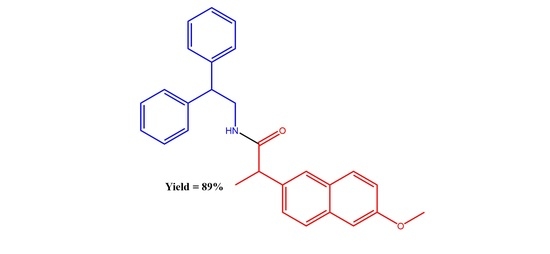N-(2,2-Diphenylethyl)-2-(6-methoxynaphthalen-2-yl)propanamide
Abstract
:1. Introduction
2. Results
3. Materials and Methods
Synthesis of N-(2,2-Diphenylethyl)-2-(6-methoxynaphthalen-2-yl)propanamide 3
Supplementary Materials
Author Contributions
Funding
Institutional Review Board Statement
Informed Consent Statement
Data Availability Statement
Conflicts of Interest
References
- Pereva, S.; Sarafska, T.; Petrov, V.; Angelova, S.; Spassov, T. Inclusion complexes of (S)-naproxen and native cyclodextrins: Supramolecular structure and stability. J. Mol. Struct. 2021, 1235, 130218. [Google Scholar] [CrossRef]
- Dong, H.; Sheng, J.Z.; Lee, C.M.; Wong, T.M. Calcium antagonistic and antiarrhythmic actions of CPU-23, a substituted tetrahydroisoquinoline. Br. J. Pharmacol. 1993, 109, 113–119. [Google Scholar] [CrossRef] [PubMed] [Green Version]
- Bernan, V.S.; Montenegro, D.A.; Korshalla, J.D.; Maiese, W.M.; Steinberg, D.A.; Greenstein, M. Bioxalomycins new antibiotics produced by the marine Streptomyces spp. LL-31F508: Taxonomy and fermentation. J. Antibiot. 1994, 47, 1417–1424. [Google Scholar] [CrossRef] [PubMed] [Green Version]
- Riggs, R.M.; Nichols, D.E.; Foreman, M.M.; Truex, L.L. Evaluation of isomeric 4-(chlorohydroxyphenyl)-1,2,3,4-tetrahydroisoquinolines as dopamine D-1 antagonists. J. Med. Chem. 1987, 30, 1887–1891. [Google Scholar] [CrossRef] [PubMed]
- Chesworth, R.; Zawistoski, M.P.; Lefker, B.A.; Cameron, K.O.; Day, R.F.; Mangano, F.M.; Rosati, R.L.; Colella, S.; Petersen, D.N.; Brault, A.; et al. Tetrahydroisoquinolines as subtype selective estrogen agonists/antagonists. Bioorg. Med. Chem. Lett. 2004, 14, 2729–2733. [Google Scholar] [CrossRef] [PubMed]
- Keith, J.M.; Barbeir, A.J.; Wilson, S.J.; Miller, K.; Boggs, J.D.; Fraser, I.C.; Mazur, C.; Lovenberg, T.W.; Carruthers, N.I. Dual serotonin transporter inhibitor/histamine H3 antagonists: Development of rigidified H3 pharmacophores. Bioorg. Med. Chem. Lett. 2007, 17, 5325–5329. [Google Scholar] [CrossRef] [PubMed]
- Trabocchi, A.; Mannino, C.; Machetti, F.; Bernardis, D.F.; Arancia, S.; Cauda, R.; Cassone, A.; Guarna, A. Identification of inhibitors of drug-resistant Candida albicans strains from a library of bicyclic peptidomimetic compounds. J. Med. Chem. 2010, 53, 2502–2509. [Google Scholar] [CrossRef] [PubMed]
- Brown, A.; Rees, D.; Rankovic, Z.; Morphy, R. Synthesis of tertiary amines using a polystyrene (REM) resin. J. Am. Chem. Soc. 1997, 119, 3288–3295. [Google Scholar] [CrossRef]



Publisher’s Note: MDPI stays neutral with regard to jurisdictional claims in published maps and institutional affiliations. |
© 2021 by the authors. Licensee MDPI, Basel, Switzerland. This article is an open access article distributed under the terms and conditions of the Creative Commons Attribution (CC BY) license (https://creativecommons.org/licenses/by/4.0/).
Share and Cite
Manolov, S.; Ivanov, I.; Bojilov, D. N-(2,2-Diphenylethyl)-2-(6-methoxynaphthalen-2-yl)propanamide. Molbank 2021, 2021, M1257. https://doi.org/10.3390/M1257
Manolov S, Ivanov I, Bojilov D. N-(2,2-Diphenylethyl)-2-(6-methoxynaphthalen-2-yl)propanamide. Molbank. 2021; 2021(3):M1257. https://doi.org/10.3390/M1257
Chicago/Turabian StyleManolov, Stanimir, Iliyan Ivanov, and Dimitar Bojilov. 2021. "N-(2,2-Diphenylethyl)-2-(6-methoxynaphthalen-2-yl)propanamide" Molbank 2021, no. 3: M1257. https://doi.org/10.3390/M1257
APA StyleManolov, S., Ivanov, I., & Bojilov, D. (2021). N-(2,2-Diphenylethyl)-2-(6-methoxynaphthalen-2-yl)propanamide. Molbank, 2021(3), M1257. https://doi.org/10.3390/M1257








